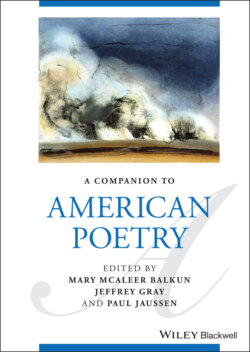Читать книгу A Companion to American Poetry - Группа авторов - Страница 31
NOTES
Оглавление1 1. David Stannard estimates that only seventy-four percent of children survived as long as their tenth birthday in Andover in Puritan times, and the mortality rate was even higher in other communities such as Boston (1975, pp. 16–18).
2 2. “May 11, 1661,” “By Night When Others Soundly Slept,” and “On My Dear Grandchild Simon Bradstreet” were among poems published posthumously in 1867.
3 3. Bercovitch notes that the motif of the sailing ship is commonly used in Puritan elegies to evoke the voyage to America (1975, p. 117).
4 4. As an enslaved writer who later acquired freedom, Wheatley connected America’s oppression by England to slavery in “To the Right Honourable William, Earl of Dartmouth” (1773), in which she explains her cruel enslavement and asks, “And can I then but pray / Others may never feel tyrannic sway?” (lines 30–31).
5 5. “Thanatopsis” was first published in The North American Review in 1817, but a revision published in 1821 replaces content added at the beginning by the editors of The North American Review with a new beginning to the poem in addition to other changes. This paper uses the revised 1821 edition.
6 6. See Martin (1984, 2007, 2019).
7 7. Year first published; year written unknown.
8 8. This paper uses the revised poem as it appeared in 1881.
9 9. See Mitford (1963) for a discussion about the increasingly elaborate and professionalized funeral in the twentieth century as well as the role of embalming.
10 10. Around 675,000 Americans and 50,000,000 worldwide died during the 1918–1919 pandemic (Centers for Disease Control and Prevention 2018).
11 11. First published in 1915; this paper uses the revised 1923 edition.
12 12. Outka further discusses bodies, rebirth, and resurrection especially in regards to the 1918 pandemic in The Waste Land in the chapter “A Wasteland of Influenza” (2020, pp. 143–166). She remarks that “Eliot and his wife both personally felt caught in a perpetual living death in the pandemic/post-pandemic moment” (p. 157).
13 13. Kami Fletcher has argued that twentieth-century African American undertakers were engaging in activism and suggests viewing “funerals [as] activist tools that proclaim three-dimensional personhood” (Fletcher/“Race & the Funeral Procession” 2018).
14 14. Doctors worked to keep people alive for as long as possible even “under the most pessimistic circumstances, where death [seemed] certain” (Warner 1959, p. 375).
15 15. The authorship is contested. The poem was published in December 1934 under the name Clare Harner, but research by Abigail Van Buren suggested that the poem was written in 1932 by Mary Elizabeth Frye, to whom it is now widely attributed.
